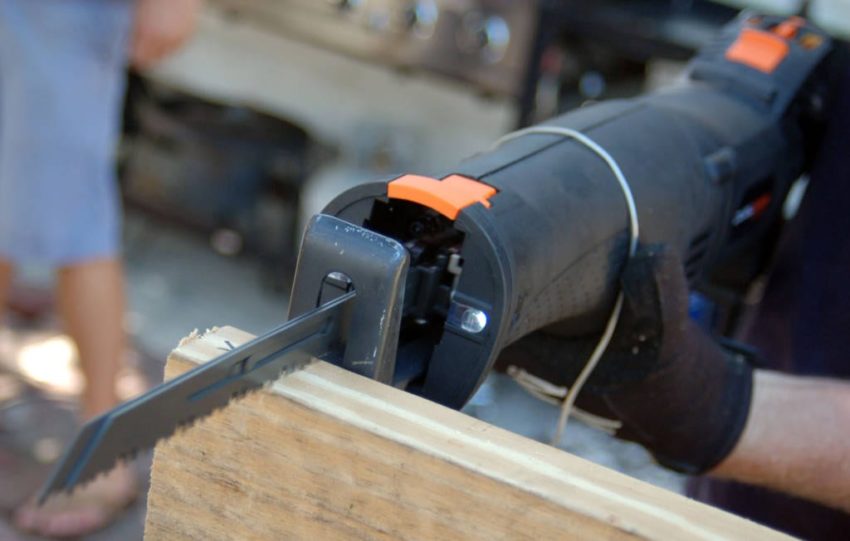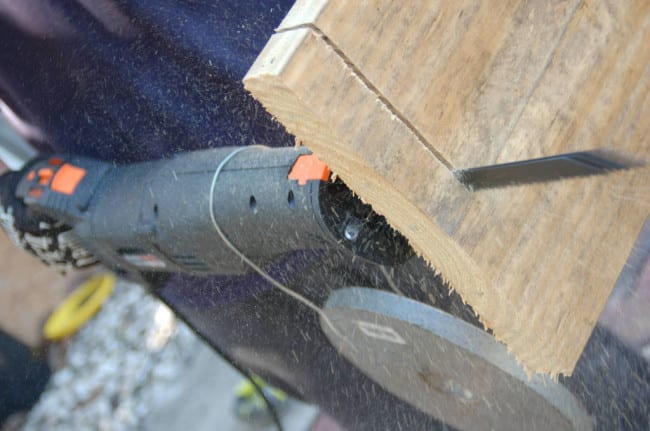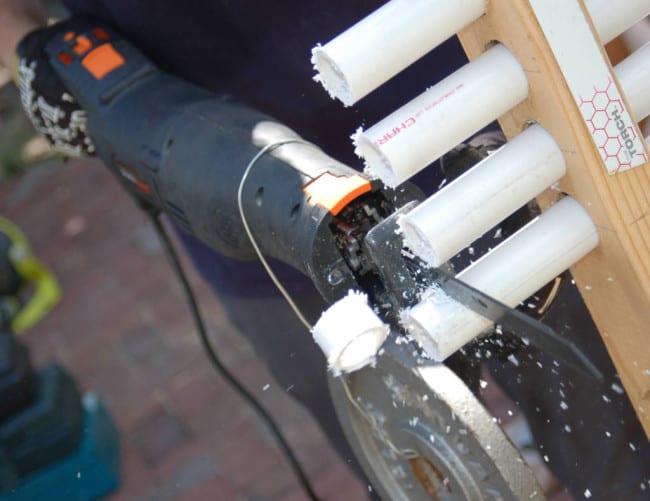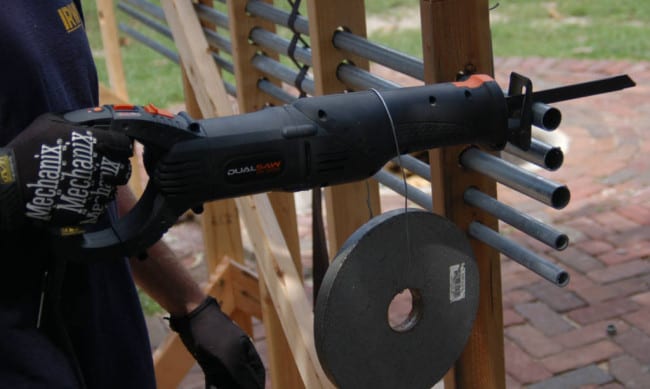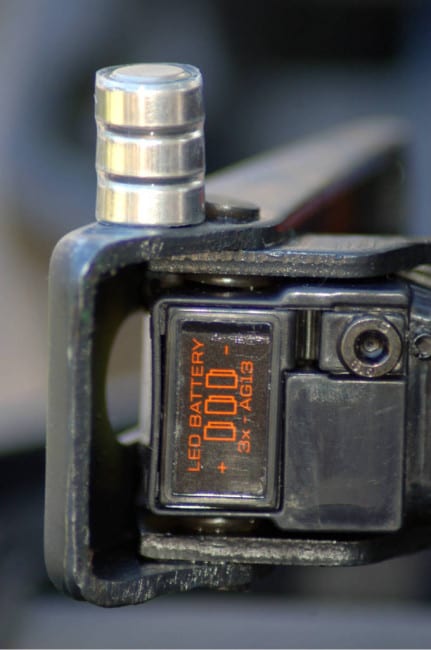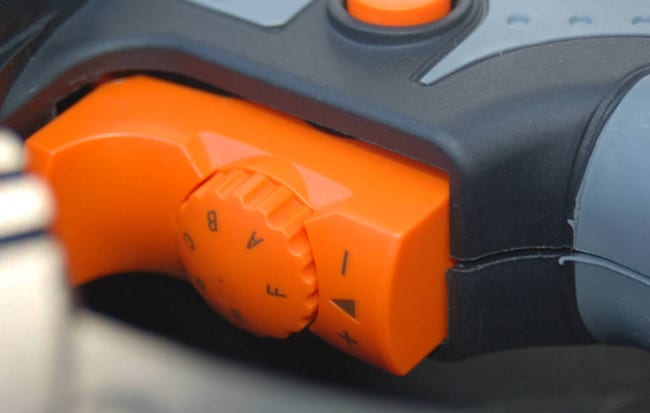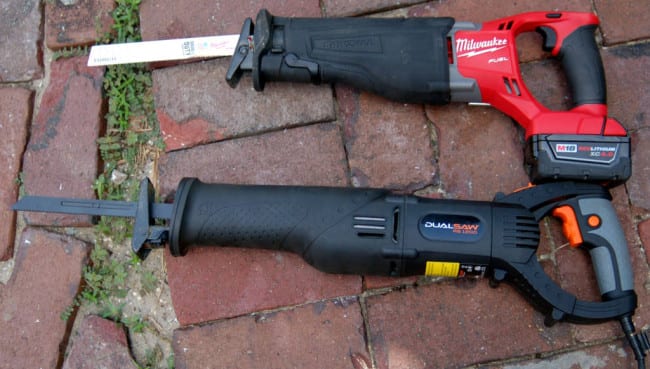Perhaps you’ve seen the commercials for Dual Tools’ DualSaw RS1200 on late night television. The outside-the-box design has sparked a lot of interest and buzz around the reciprocating saw end of the industry, but how does it actually perform?
The DualSaw RS1200 features a twin blade design that cuts in opposing directions through the material. According to Dual Tools’ website, this action helps to stabilize the cut, reduce vibration, and reduce kickback. It claims to be “the safest, smoothest, and most versatile reciprocating saw ever built.”
DualSaw RS 1200 Specs
- Power Source: 12 amp corded motor
- Voltage: 120 volts
- Length: 19 inches
- Speed: 2500 strokes per minute
- Weight: 9.8 pounds
- Stroke Length: 3/4 inch or 1-1/4 inch
For features on the DualSaw RS1200 it starts with those counter action blades. You have the option of 3/4 inch or 1-1/4 inch stroke lengths. The handle can rotate 180 degrees. There are a pair of front mounted LED lights. The variable speed trigger is complemented by a soft start motor that gradually works up to full power.
We are told that the DualSaw RS1200 is targeted towards the professional and serious DIY users that will need a reciprocating saw on a semi-regular to regular basis. Novice users are also encouraged to consider the DualSaw for it’s lower vibration and reduced kickback over traditional single blade saws.
Testing the DualSaw RS1200
The DualSaw RS1200 arrived just in time to go through the tests we had set up for our heavy duty reciprocating saw shootout. It was tested along with models from Milwaukee, Makita, Bosch, DeWalt, Ryobi, and Hitachi. When it comes to power, the DualSaw fits in with the models from Hitachi, Ryobi, and DeWalt. At $199, it matches Milwaukee and Makita for price point.
There were three types of cuts that each saw was required to make to simulate applications as a demolition tool. First was nail embedded wood. We didn’t have the nail embedded wood blades for the DualSaw, so we cut through just the 2 x 12 pressure treated board with no nails present using the standard wood blades. Second, a series of four 1 inch PVC pipes using the multi-purpose blades. Finally, we used the metal blades to cut through 5 galvanized pipes.
So that the amount of downward force was constant, each saw was pulled down by a 10 pound weight.
How Did the DualSaw RS1200 Do?
For cutting through the wood, the fastest cut time we saw when sending each saw through 3 separate runs of nail embedded wood was 7.70 seconds by a 15 amp saw. The slowest by a 12 amp saw was 12.31 seconds and the slowest by any of the other saws was 13.82 seconds. The DualSaw RS1200 took 35.38 seconds without nails embedded in the wood.
In the PVC test, the fastest cut was again a 15 amp saw that took 6.90 seconds. The slowest was a 10 amp saw at 10.04 seconds. The slowest 12 amp saw cut through at 9.69 seconds. The DualSaw’s fastest cut was 16.74 seconds.
For the galvanized pipe cutting test, the 15 amp saws ruled the pack as expected. The fastest cut was 14.17 seconds. The slowest overall cut in the shootout was 22.03 seconds with the slowest 12 amp cut at 21.67. The DualSaw took 40.04 seconds in its fastest test.
There were more considerations than just speed. Anyone who has used a reciprocating saw knows the amount of vibration that goes along with it. Using a tool like that all day can be torture on your arms. While there were a couple of models that were very impressive in terms of the lack of vibration, the DualSaw RS1200 did indeed have the least amount of vibration and the smoothest cut of all the saws we tested.
Note: In our testing methods, the timer was started at the pull of the trigger. This means that the soft start is included in the total time to cut, and the DualSaw has an intentionally slow soft start to help maintain control and reduce vibration.
Why the Disappointing Performance in Speed for the DualSaw RS1200?
We were disappointed to see how slowly the DualSaw RS1200 performed compared to the other saws we tested. This can be attributed to a couple of reasons.
The DualSaw RS1200 features a soft start motor. When I say soft start, I mean fluffy pillow soft. It starts very slowly, which leads to less vibration and more stability in your cut. While we can appreciate a soft start to help us get going, this was too slow. In fact, on the galvanized pipe, we had to relieve the pressure on the blade as it tried to start so it would actually move.
We sat around pondering other reasons for the lack of speed. It comes down to physics really. You have a 12 amp motor cutting with 2 blades that are each the same rough width as the blades we used in our shootout. This means that the blades are removing twice the amount of material. Another way to consider it is that each blade can only utilize about half the power of the motor. Either way, the result is slow speed. For what the DualSaw is trying to do, it is significantly underpowered.
Other Considerations
There are some things that can be improved on the DualSaw RS1200. First is the LED lights on the front. I’m all for having them, but not for powering them with button cell batteries on a corded recip saw. Even though LED lights are efficient, the cost of ownership goes up when you have to replace batteries. This shouldn’t be the case with any corded tool.
The speed dial is actually on the variable speed trigger. I had to completely stop and turn the tool to see the markings on it and change speeds. Ideally, this needs to be moved to the side or top of the housing where it can be seen and adjusted more easily.
The DualSaw RS1200 is long and heavy. Coming in at almost 10 pounds according to the spec sheet, it is up there with the heaviest models we tested. If I’m going to suffer through cuts that take more time, I’d like there to be a trade off in lower weight. It’s also almost 4 inches longer than the other saws we tested. While you can probably get used to the additional length, it was an inconvenient adjustment to deal with compared to the recip saws I’m accustomed to using.
The DualSaw features a cam gear design as opposed to a “wobble” bearing like traditional recip saws. This motor design is part of the reason that the DualSaw’s vibration is so low but also why the length is more significant than other recip saws. The fact that the DualSaw is driving two blades in opposite directions means that it needs twice the components, accounting for the additional weight.
The rotating handle is a really nice feature. When you are working around demo applications, material is rarely nice enough to stand up straight for you. I really appreciated being able to adjust the angle to find the most comfortable cutting position.
The DualSaw RS1200 uses a twin blade system that no other manufacturer makes. That means you can only buy DualSaw blades to fully appreciate the total design experience. In our shootout, we chose to use Milwaukee Ax and Torch Blades for good reasons. If you have a brand of blade that you prefer, break a blade, or simply don’t have a DualSaw blade for the application at hand, you can install a single blade of your choice to complete the job.
Bottom Line Conclusions
When it comes to the claims of being safe and smooth, the DualSaw RS1200 is that for sure. The rotating handle is nice. I’m afraid that’s where my compliments end though.
The weight, length, and slow cutting performance are just too much to overcome. Separate battery power for LED lights on a corded tool just makes no sense to me at all. When you toss in the price point and the fact that you can only use DualSaw blades, it’s really difficult to recommend this tool to anyone.
The DualSaw is designed to accept anyone’s blades with a universal fit. If you break a blade, or simply need one that you don’t have, you can install a single recip saw blade of your choice on the DualSaw.
For performance, even the 10 amp saw we tested beat out the DualSaw RS1200 handily. At $199, you can buy Milwaukee’s top of the line Sawzall. If you’re a professional or serious DIY enthusiast, we recommend that you look at other options for a demolition tool. If you’re a novice, you might appreciate the lack of vibration and extreme soft start for occasional use.
Editor’s Note: I had the chance to chat with Chad Allison of DualTools following the publishing of our review. Please note several clarifications that we’ve made in italics to better help you understand the design intent of the DualSaw RS1200. The DualSaw was not intended to contend in speed with the other recip saws on the market, but to be safer and produce much less vibration. In terms of hitting those goals, the DualSaw does perform very well.
According to Chad Allison, the question that they ask when designing their tools is “How can I make this the best experience that I can for the user?” That experience is less about speed and more about taking the vibration away that the user experiences in the aggressive cutting nature of the recip saw.

